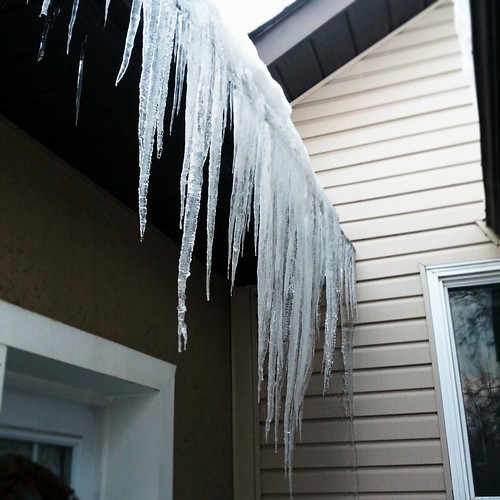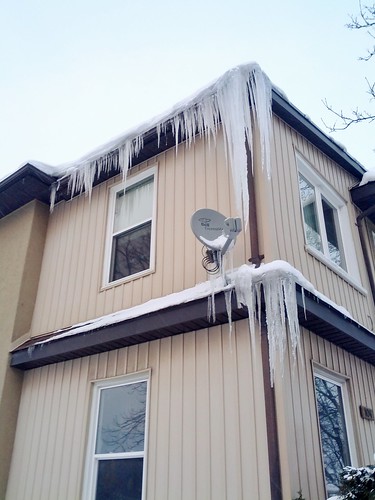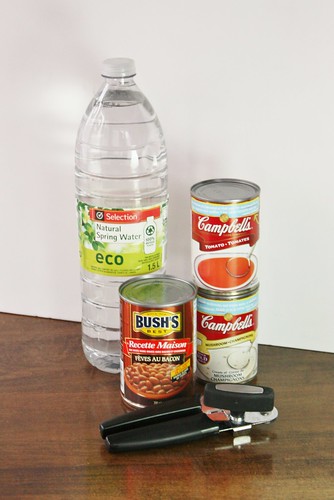
Just look at these icicles hanging over our front door. I have to walk under these things to get in/out. I’m constantly afraid of being struck by one of them.

And look at how big that one is on the second story of the house! Does anyone else feel like we’re living in the movie FROZEN this year? Disney really did pick the perfect time to release it.
With the ice storm this past December and all the crazy weather in places like Atlanta last month, it reminded me that we needed to update our emergency plan and check on all our supplies. We’ve had friends and family without power in earlier this winter for 8 days, and it got me wondering what we would do in that situation. We’ve been lucky that the only time we lost power for a week was in one summer and it was only a brown out so we still had access to showers at our gym and we could grab food out if we needed to.
What if we couldn’t leave our home? Or what if we had to evacuate?

Our apartment is small, so we keep our supplies in two areas – our pantry and our front hall closet. If we had a larger home, I would like to keep everything in one container that is easy to carry in case of a flash flood or fire. We have friends who have whole shelving units of supplies in their homes in case they need them for a flood, fire, tornado, snow storm, zombie apocalypse, and I really think it’s a fantastic idea to be prepared as much as you can. I even gave Garrett a survival guide for Christmas this year with suggestions on how to get yourself out of various situations. Talk about light bedtime reading, right?
Emergency Bin Contents List
Contents List – There will be times when you need to replace items in your emergency bin, such as expired food and clothing. Here is a printable Word version, with space for you to add on additional supplies that are important to you. If you need to add “chocolate” on there, I won’t judge.
Contact List – Create a list of all emergency numbers and family phone numbers. If your cell phone dies, you will not be able to get those that are stored in your phone. Writing them down ensures that you have them all on hand. Store in a plastic bag, along with a the Emergency Bin Contents List.
Water – One gallon of water per day per person, for at least three days.
Food – A three day supply of non-perishable food, such as canned foods, energy bars, ready-to-eat soups and dry goods. Pick foods that require little preparation/cooking, no refrigeration and very little water. Don’t forget to include a can opener!
Batteries/Solar Energy – An extra supply of batteries can come in handy with important electronics like radios and flashlights. A solar charger is a great way to charge your phone in an emergency situation.
Light – Keep a supply of emergency candles and flashlights. Store matches in a plastic bag in case of water damage. Include a lighter that is filled with fuel, and extra batteries for the flashlight. A camping headlight is another good thing to have on hand. Glow sticks are a fun idea for kids, especially at night.
First Aid Kit – Regularly check your first aid kit to make sure it is stocked. Don’t forget to include important prescriptions such as heart medication, inhalers and epipens, if needed. Make sure that your kit includes an emergency blanket, which helps to keep heat in.
Radio – A battery-powered or hand crank radio is important when there is an emergency and power lines are down.
Basic Tools – A knife, hammer, screwdriver wrench and pliers are all important to tools to keep on hand in the event that you need to turn off utilities.
Camping Supplies – Keep your camping supplies together in case you need to go on the road. Sleeping bags, tents, an axe and a butane camp burner are all useful tools in an emergency.
Pets – Keep a supply of food, water, litter and any medications for your pets as well. Whenever I get those little sample bags of dog food at events, I toss a couple into our pantry for emergency situations.
Change of Clothing – Before you send off your old clothes for donation, keep a change of clothes for each person, including long sleeve shirts, shoes, hats and gloves.
Fire Extinguisher – Aside from keeping one of these in your kitchen, keep one in your kit too.
Money – If the power goes out, credit cards and bank machines won’t be working. Set aside emergency cash for those times.
Map – Mark down the evacuation route for your area. Circle key locations such as hospitals and police stations.
Entertainment – Keep a stash of books, playing cards and board games. Travel size versions work well.
Car Kit – Keep an emergency kit in your car that includes jumper cables, flares and a basic first aid kit. In the winter, we put old coats, sleeping bags, mitts and hats in our car in case we get stuck in the snow.

Packing a bin is important, but there are also additional measures you can take when you know that an emergency is potentially coming your way. This Emergency Preparation Checklist gives you a quick overview of what to do when you think you could be in trouble soon. If you live in colder climates that are prone to winter storms like those we’ve been having lately, these are great preventative measures you can take to ensure you and your family and safe this winter.
Emergency Preparation Checklist
- Fill your gas tank and top up windshield washer fluid.
- Double check the Contents List for your Emergency Bins.
- Grab some extra cash, in case the power goes out and ATMs don’t work.
- Turn your fridge and freezer to a colder setting & if you lose power keep the doors closed as much as possible.
- If you have extra space in your freezer, fill the extra space with containers or plastic bags full of water. It will help keep it colder longer. A freezer that is half full will hold food safely for up to 24 hours. A full freezer will hold food safely for 48 hours.
- Charge all electronic devices and keep them charged.
- Check your sump pumps.
- Clean out your gutters before the storm comes and make sure that the storm drains on your street are clear from all the fall foliage.
- If needed, board up your windows and stay away from them
- Have everyone one sleep in the same room. You’ll know where everyone is and it will help to conserve heat.
- Make a few meals and snacks that do not require refrigeration.
- Have your prescriptions filled.
- If you have a BBQ, make sure you have a full tank of propane. Do not use a BBQ to heat an indoor space, as it can lead to carbon monoxide poisoning or fires.
- Do your laundry now, so you have clothes that are dry and clean.
- Make sure you have a solar charger or car charger for your cell phone.
- If you have a fireplace that you can use to cook or for heat, have a supply of wood.
- Check with your elderly and family to make sure they are prepared or invite them over. Be ready to help your neighbors.
- Find your glasses so you don’t have to deal with contacts in an emergency.
- Fill large 40 gallon containers with water and storing them in the tub. COVER all bins/tubs of water to keep kids and pets safe.
- Be careful of carbon monoxide when using gas heaters/stoves or candles.
- Take pictures of every room and closet in your house – this will be invaluable if you need to deal with insurance companies afterwards.
- If you have to use a gas-powered generator, make sure to have a extra fuel on hand. Be very careful where you put it and be aware of local laws on how much you can have on hand at one time.
- Don’t forget to pay attention to fire prevention measures. Have your fire extinguisher handy.
I truly hope that we’re never in a situation where we need to use it, but having a back up plan puts my mind at ease. I’d like to think that in the event that The Walking Dead is some indication of the chaos that could ensue, we’d be somewhat prepared and self sufficient…or at the very least faster than the zombies. Maybe I need to increase my cardio at the gym…
